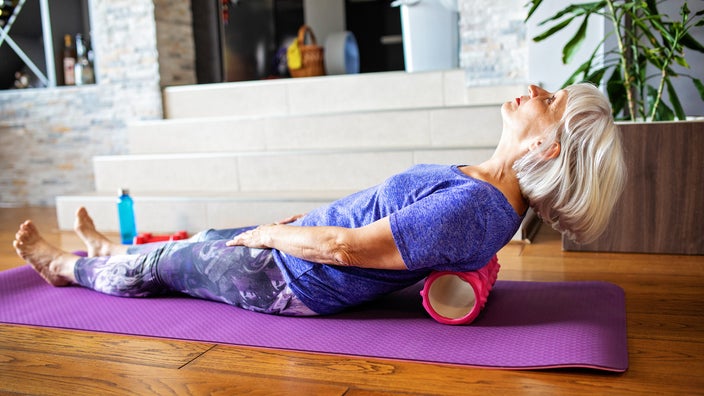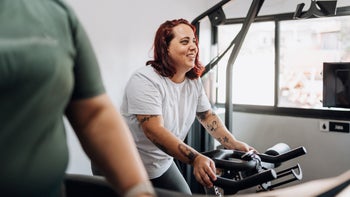
10 Ways to Relieve Sore Muscles After a Workout
Key takeaways:
Muscle soreness after a new or strenuous workout is common.
There are research-backed methods, including heat and compression therapy, that may help sore muscles after a workout.
Delayed-onset muscle soreness (DOMS), or muscle pain after exercise, is not usually a cause for concern. But you should see your primary care provider if your pain is severe or lasts longer than a week.
Table of contents

You just signed up for a gym membership, and you're putting it to good use. But by day two of your new fitness plan, your muscles are already achy and sore. Sound familiar? Muscle soreness is common after a new or strenuous workout. And while it can be uncomfortable, it doesn't have to interrupt your routine.
Your first instinct might be to reach for an over-the-counter pain reliever. But there's more than one way to soothe sore muscles. These 10 research-backed methods can help you get rid of sore muscles after a workout and boost muscle pain relief.
1. Practice active recovery
Evidence suggests that static stretching after a workout won't help with muscle soreness. But active recovery might. Active recovery is low-intensity exercise designed to help your muscles recover from a higher-intensity workout.
Search and compare options
You can incorporate active recovery into your fitness routine in a few different ways:
During your workout: With interval training, you switch between short bouts of high-intensity exercise and brief recovery intervals.
After your workout: You can practice slow, easy movement like walking during your cooldown sequence after a vigorous training session.
On rest days: Take advantage of your rest days by doing gentle activities like yoga, swimming, or walking.
2. Opt for ice or heat therapy
The debate over whether to apply ice or heat to sore muscles may never end. Even the research on the topic is mixed. Though, while there might not be a clear winner, both ice and heat therapy can help sore muscles.
Understanding how each method works can help you decide whether to apply ice or heat to your muscles when they’re sore. Cold therapy slows circulation, which may reduce swelling and related pain. This is useful for new injuries or pain. Heat therapy increases circulation, which may aid muscle recovery by relieving tight, sore muscles. This method is helpful for older injuries or pain.
One review found that using ice or heat therapy within 1 hour after exercise soothes muscle aches. In the review, cold therapy strategies, like ice baths, had pain-relieving effects for up to 24 hours, while the effects of applying heating pads lasted longer than 24 hours. So you might start with ice therapy and switch to heat therapy as delayed-onset muscle soreness (DOMS), muscle pain after exercise, peaks. And since the evidence is mixed, you can try one or both methods to find what works best for you.
3. Try foam rolling
Foam rolling is a type of myofascial release, or self-massage. It's been shown to reduce muscle pain and stiffness and improve range of motion. This technique uses a foam roller (a cylindrical tube made of foam) or another tool to massage your fascia, the connective tissue that holds your muscles, tendons, and ligaments together.
You can try foam-rolling exercises after your workouts. (One small study found that post-exercise foam rolling may reduce pain and improve athletic performance.) Or you can do them to warm your muscles up before exercise.
If you're new to foam rolling, you might want to start with a smooth, low-density foam roller or massage ball. Both are softer and may be more comfortable than firmer rollers.
Read more like this
Explore these related articles, suggested for readers like you.
4. Consider massage therapy
If self-massage isn't your thing, you can go to a professional massage therapist. Post-exercise massage promotes muscle recovery by reducing inflammation.
A 2012 review found that getting a massage 4 hours after high-intensity exercise may reduce pain from muscle soreness and improve muscle performance. Another study found that massage was more effective than other recovery strategies, such as active recovery and contrast hydrotherapy.
5. Wear compression gear
Wearing compression gear after a workout may speed up muscle recovery and blood circulation. In a small-scale study, endurance runners wore compression socks during a 1-hour recovery period between 5Ks. They reported less muscle soreness during recovery than usual and could run just as fast during the second 5K.
But compression gear isn't just for athletes. In a different study, inactive adults wore compression socks while working out. Compared to when they wore regular socks, the participants had significantly less muscle soreness after 24 and 48 hours.
6. Use kinesiology tape
Many athletes swear by kinesiology tape for muscle pain relief, injury prevention, and better performance. Evidence is mixed on whether or not it can boost your athletic performance. But studies show that the flexible adhesive may ease muscle pain after strenuous exercise.
7. Apply essential oils
People use essential oils for numerous health and wellness concerns. Applying them may help with muscle pain and stiffness, but more research is needed. If you do try essential oils for sore muscles, there are plenty of options, including lavender and rosemary oil. But be sure to look for quality products.
Essential oils are highly concentrated and can irritate your skin. So remember to dilute them with a carrier oil before applying them directly to your skin. You can start with a patch test and then use small amounts of diluted oil on achy muscles.
8. Add anti-inflammatory foods to your diet
Ongoing research shows that certain diets, including those full of anti-inflammatory foods, can help with DOMS. For example, in a small study, runners drank tart cherry juice, which is known for its anti-inflammatory properties, for 7 days before a race. And they had less muscle pain after the race than those who did not.
But you don't have to focus on one food. Aim for a balanced diet with various anti-inflammatory foods, which contain antioxidants and other nutrients that may aid muscle repair and relieve pain. Some examples include fatty fish, watermelon or beetroot juice, and certain caffeinated drinks.
9. Hydrate before, during, and after exercise
You probably already know that proper hydration helps fuel your workouts. Hydration is critical for exercise performance and muscle repair after training. And some evidence suggests that dehydration may increase the symptoms of DOMS and prolong recovery. So your post-workout pain could be worse if you don't stay hydrated.
For proper hydration, opt for water or electrolyte drinks based on your exercise intensity.
10. Get a good night’s sleep
Don't underestimate the power of a good night's sleep. Quality sleep can boost everything from your heart health to your mood. And it's essential for muscle recovery.
Adequate sleep –– 7 to 9 hours a night for adults –– allows your muscles to repair and grow after exercise. Lack of sleep has been linked to higher pain sensitivity. So getting enough sleep could make DOMS feel less intense.
Why do your muscles get sore after a workout?
DOMS is your body's response to physical stress. Muscle pain after exercise can happen to anyone, including experienced athletes. But it's common in people who are new to exercise and those who return to exercise after a long break.
New, higher-intensity, or repetitive exercises may cause tiny tears in your muscle fibers. That microscopic damage triggers inflammation as your muscles recover and adapt to unfamiliar stress. This process helps you build muscle mass. But researchers believe that the inflammation is also responsible for post-workout muscle soreness and aches.
How long does muscle soreness usually last?
DOMS typically starts 12 to 24 hours after exercise, with the worst pain occurring around 48 to 72 hours after your workout. And muscle soreness isn’t the only possible symptom. DOMS may also cause muscle swelling, tenderness, stiffness, and weakness. The good news is that it usually resolves in 5 to 7 days.
Should you work out with sore muscles?
Deciding whether or not you should exercise with sore muscles depends mainly on your symptoms. Generally, DOMS is not a cause for concern. You probably don't need to avoid exercise if you have minor aches and pains.
Instead of avoiding exercise, you can try cross-training while your muscles heal. This workout method incorporates various exercise styles — like aerobics, strength training, and stretching — into one fitness plan. It allows you to keep training while sore or injured.
For example, if your arms are sore after a new upper body resistance workout, you can cross-train with a lower body session. Or you can opt for gentler, low-impact activities like tai chi or yoga until the aches and pains subside. Experts recommend waiting 2 to 3 days before targeting the same muscle group in workouts.
While minor aches and pains aren’t usually cause for concern, severe symptoms, like extreme muscle soreness, might need medical attention.
When should you see a healthcare professional for muscle soreness?
DOMS isn’t usually a reason to seek medical attention. But you should see your primary care provider if you have:
Severe or debilitating pain
Very swollen limbs
Loss of range of motion due to severe swelling
Dark urine or less frequent urination
Persistent pain that lasts longer than a week
These may be signs of other problems that your provider can diagnose and treat.
The bottom line
Delayed-onset muscle soreness (DOMS) after a new or intense workout may signify muscle recovery and growth. But it can also be very uncomfortable and hinder your fitness routine. Natural remedies — such as compression socks or essential oils — could have you saying goodbye to sore muscles before you know it.
Why trust our experts?



References
Afonso, J., et al. (2021). The effectiveness of post-exercise stretching in short-term and delayed recovery of strength, range of motion and delayed onset muscle soreness: A systematic review and meta-analysis of randomized controlled trials. Frontiers in Physiology.
American College of Healthcare Sciences. (2017). 3 common and dangerous essential oil mistakes.
American College of Sports Medicine. (2011). Delayed onset muscle soreness (DOMS).
Bakó, E., et al. (2023). Efficacy of topical essential oils in musculoskeletal disorders: Systematic review and meta-analysis of randomized controlled trials. Pharmaceuticals.
Brophy-Williams, N., et al. (2016). Effect of compression socks worn between repeated maximal running bouts. International Journal of Sports Physiology and Performance.
Centers for Disease Control and Prevention. (2021). How does sleep affect your heart health?
Chen, H. Y., et al. (2019). Effects of caffeine and sex on muscle performance and delayed-onset muscle soreness after exercise-induced muscle damage: A double-blind randomized trial. Journal of Applied Physiology.
Clifford, T., et al. (2016). The effects of beetroot juice supplementation on indices of muscle damage following eccentric exercise. European Journal of Applied Physiology.
Crane, J. D., et al. (2012). Massage therapy attenuates inflammatory signaling after exercise-induced muscle damage. Science Translational Medicine.
Da Silva, G. L., et al. (2015). Antioxidant, analgesic and anti-inflammatory effects of lavender essential oil. Anais da Academia Brasileira de Ciencias.
Dupuy, O., et al. (2018). An evidence-based approach for choosing post-exercise recovery techniques to reduce markers of muscle damage, soreness, fatigue, and inflammation: A systematic review with meta-analysis. Frontiers in Physiology.
Guo, J., et al. (2017). Massage alleviates delayed onset muscle soreness after strenuous exercise: A systematic review and meta-analysis. Frontiers in Physiology.
Halcón, L. (n.d.). How do I determine the quality of essential oils? Taking Charge of your Health & Wellbeing, University of Minnesota.
Hendricks, S., et al. (2020). Effects of foam rolling on performance and recovery: A systematic review of the literature to guide practitioners on the use of foam rolling. Journal of Bodywork and Movement Therapies.
Herbert, R. D., et al. (2011). Stretching to prevent or reduce muscle soreness after exercise. The Cochrane Database of Systematic Reviews.
Hotfiel, T., et al. (2018). Advances in delayed-onset muscle soreness (DOMS): Part I: Pathogenesis and diagnostics. Sportverletzung Sportschaden.
Hughes, M. (2012). Myofascial release (MFR): An overview. Hospital for Special Surgery.
Kim, J., et al. (2014). A review of nutritional intervention on delayed onset muscle soreness. Part I. Journal of Exercise Rehabilitation.
Kim, K., et al. (2020). Local heat therapy to accelerate recovery after exercise-induced muscle damage. Exercise and Sport Sciences Reviews.
Krause, A. J., et al. (2019). The pain of sleep loss: A brain characterization in humans. Journal of Neuroscience.
Kuehl, K. S., et al. (2010). Efficacy of tart cherry juice in reducing muscle pain during running: A randomized controlled trial. Journal of the International Society of Sports Nutrition.
Lin, J., et al. (2021). Effects of kinesio tape on delayed onset muscle soreness: A systematic review and meta-analysis. BioMed Research International.
Macdonald, G. Z., et al. (2014). Foam rolling as a recovery tool after an intense bout of physical activity. Medicine and Science in Sports and Exercise.
Michalak, M. (2018). The use of carrier oils in aromatherapy massage and their effect on skin. Archives of Physiotherapy and Global Researches.
Monteiro, E. R., et al. (2019). Effects of different between test rest intervals in reproducibility of the 10-repetition maximum load test: a pilot study with recreationally resistance trained men. International Journal of Exercise Science.
Montoye, A. H. K., et al. (2021). The effect of compression socks on maximal exercise performance and recovery in insufficiently active adults. International Journal of Exercise Science.
Peake, J. M., et al. (2017). Muscle damage and inflammation during recovery from exercise. Journal of Applied Physiology.
Peake, J. M., et al. (2017). The effects of cold water immersion and active recovery on inflammation and cell stress responses in human skeletal muscle after resistance exercise. The Journal of Physiology.
Pearcey, G. E. P., et al. (2015). Foam rolling for delayed-onset muscle soreness and recovery of dynamic performance measures. Journal of Athletic Training.
Qamar, M. M., et al. (2019). Beat the exercise-induced muscle damage. Journal of the Pakistan Medical Association.
Rezaee, M., et al. (2019). Effect of essential oil of rosemary on eccentric exercise-induced delayed-onset muscle soreness in non-active women. Comparative Exercise Physiology.
Reneker, J. C., et al. (2018). Effectiveness of kinesiology tape on sports performance abilities in athletes: A systematic review. Physical Therapy in Sport.
Rosário Júnior, A. P., et al. (2021). Repeated bout effect and EPOC: A narrative review. International Scientific Journal Of Kinesiology.
Schoenfeld, B. J., et al. (2010). The mechanisms of muscle hypertrophy and their application to resistance training. Journal of Strength and Conditioning Research.
Schwarz, P., et al. (2013). Sleep deprivation impairs functional muscle recovery following injury. Sleep Medicine.
ScienceDirect. (n.d.). Delayed onset muscle soreness.
Tarazona-Díaz, M. P., et al. (2013). Watermelon juice: Potential functional drink for sore muscle relief in athletes. Journal of Agricultural and Food Chemistry.
Triantafillou, S., et al. (2019). Relationship between sleep quality and mood: Ecological momentary assessment study. JMIR Mental Health.
U.S. Anti-Doping Agency. (n.d.). Fluids and hydration.
VanDusseldorp, T. A., et al. (2020). Impact of varying dosages of fish oil on recovery and soreness following eccentric exercise. Nutrients.
Wang, Y., et al. (2021). Heat and cold therapy reduce pain in patients with delayed onset muscle soreness: A systematic review and meta-analysis of 32 randomized controlled trials. Physical Therapy in Sport.





























